review by Chrischona Schmidt
Utopia: The Genius of Emily Kame Kngwarreye was on display between 22 August and 12 October 2008 at the National Museum of Australia in Canberra. With approximately 100 examples of Emily Kame Kngwarreye works, the exhibition gives an overview of the almost 3000 artworks Emily painted in the last eight years of her life. The exhibition begins with a film and leads the visitor through various phases of her artworks to the back room, which contextualises her art practice, back through the phases to the film room at the beginning.
This multi-layered exhibition takes its visitors on several journeys. One of them is from Utopia, in the Central Desert of Australia, to Osaka and Tokyo in Japan and finally back to Canberra and the National Museum of Australia. Another journey is through Kngwarreye's Country, Alhalkere [1], which is situated approximately 230 kilometres north-east of Alice Springs. Yet another journey is through Kngwarreye's later life, shown as different phases in her artworks. The fourth journey is through time, and describes the reception of her work.
The first journey is remarkable in itself. In 1998, at the Queensland Art Gallery, a retrospective of Kngwarreye's work Emily Kame Kngwarreye: Alhalkere — Paintings from Utopia was first shown. Afterwards, this exhibition travelled through Australia. Unfortunately, Emily, as she is widely and affectionately known, never had the opportunity to see the exhibition, as she passed away in 1996, estimated in her mid 80s. Kngwarreye was the first Indigenous artist in Australia to have a major national touring retrospective of her work. This show caught the attention of the Japanese art historian Akira Tatehata. He felt so touched and was so fascinated by her work that he felt compelled to take her art to Japan. A decade later this dream of his came true and her works were shown in a solo blockbuster exhibition, first in Osaka and then in Tokyo (where it broke the record of attendance for a major contemporary art exhibition, previously held by an Andy Warhol exhibition).
As Utopia: The Genius of Emily Kame Kngwarreye is a collaborative effort between several institutions, including the Australian Embassy in Japan and the National Museum of Australia, it has also been shown in Australia, but only at the National Museum. Around 130 artworks were on show in Japan. In Canberra the exhibition is slightly reduced owing to limited space of the gallery. The story of how the exhibition came about is described in a film in the introductory room as well as through another film of the unwrapping in Japan of the Big Yam Dreaming 1995 in the Yam section.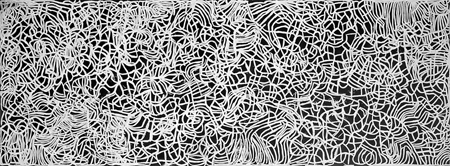
synthetic polymer paint on canvas, 291.1 x 801.9 cm
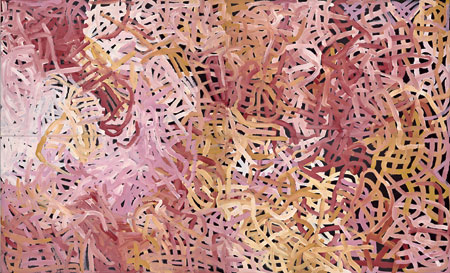
synthetic polymer paint on canvas, 4 panels, each 159.0 x 270.0 cm, overall 245.0 x 401.0 cm
purchased by the National Gallery Women's Association to mark the directorship of Dr Timothy Potts, 1998
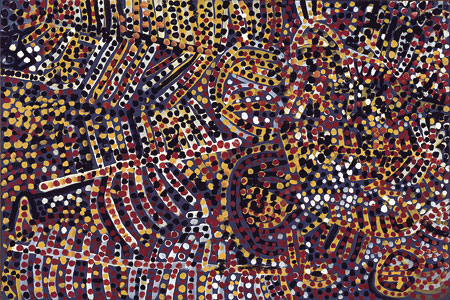
Emu Woman 1988–89
synthetic polymer paint on canvas, 92.0 x 61.0 cm
The Holmes à Court Collection, Heytesbury
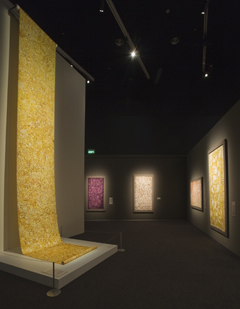
batik on silk, 1000.0 x 112.0 cm
photograph by Lannon Harley
The early work on show not only includes Emu Woman 1988–89 but also works produced prior to Kngwarreye's first paintings on canvas. Kngwarreye began painting at about the age of 78. However, before she began to paint on canvas she was closely involved with the Utopia Women's Batik Group workshops in the community. These started in the late 1970s and were instigated by Jennifer Green and Julia Murray. Next to Emu Woman and on the other side of the wall, on which Big Yam is hung, some examples of her batiks are presented. The batiks are hung on the wall like the paintings, apart from one, Untitled 1988, which appears to float down from the ceiling. The hanging allows for the light to have an impact on the colours and when the batik moves it seems almost as if a golden flood of leaves and seeds is flowing downwards. It was described to the Australian Prime Minister's wife, Therese Rein, by the Japanese Empress as 'a golden cascade'.[3] In this exhibition, only a snapshot of Kngwarreye's batiks are on show and the visitor does not have the opportunity to compare her development as an artist working with batiks or before that with body paintings for ceremonies with the later works on canvas. The batiks are included as a transition between body painting and painting on canvas. There are two early batiks from 1981 and, in the Utopia room, images of body painting in the footage, a photo of her painted up, and a set of body painted black sculptures.
Upon entering the exhibition space the visitor is immediately immersed in Kngwarreye's world. The quotation on the wall makes it clear that her works always refer to her Country and her connectedness to Country. In order to show Emily's different visions of her Country, the exhibition groups the artworks in seven themes that chronologically parallel her stylistic development: Origins, Field of Dots, Colourism, Body Lines, Yam, Sacred Grasses and the Last Series. Each of these themes sums up a period of about a year. The path of the exhibition tour leads the visitor through these phases, yet they seem dominated by the two major works around which the exhibition seems to circle: The Alhalker[e] Suite 1993 and the above-mentioned Big Yam Dreaming 1995. One is an explosion of colours and the other a reduction of them, as well as of Kngwarreye's vocabulary of forms.![The Alhalker[e] Suite 1993 painting](https://recollections.nma.gov.au/__data/assets/image/0011/330968/22-The_Alkhere_suite_lo_res_450_web.jpg)
synthetic polymer paint on canvas, 22 panels approx 120 x 90 cm each
Although visible from almost every location within the gallery, it is only at a few standpoints that the visitor can view these two artworks at their full scale. This limits the appreciation of them and gives an impression of the exhibition space being too confined for these large artworks that 'breathed' so well in Tokyo and gave the visitor space to look at them from every angle possible.[4]
Behind Big Yam Dreaming 1995 a contextualisation or Utopia room is situated. Here the visitor can find information on the community and the significance of art within it. This room gives an insight into the underlying and inspiring themes — Dreaming and Country — of the art from Utopia and therefore Kngwarreye's art. Furthermore the room gives the visitor the opportunity to understand the connectedness of mark making — such as body painting — and painting in Kngwarreye's art. For example some images are on show of Kngwarreye painted up and some carvings are displayed that help the visitor to see this connection. From this room the visitor is led back through the other half of the exhibition, and exits alongside the great Earth's Creation and an explosion of colours.
As the themes are arranged chronologically, the exhibition leads the visitor step-by-step through the last eight years of Emily's life, showing her experiences expressed through painting. It seems that she really tried to tell the 'whole lot' in her paintings. She did not just paint Country, but her life in her Country. The Country's story is her story. The visitor leaving the exhibition is struck by this journey, through her life in Country and as an artist.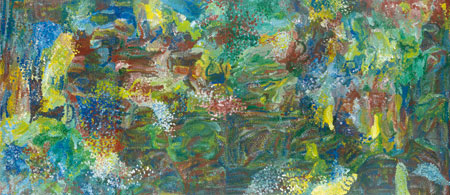
synthetic polymer paint on canvas. 4 panels, each 275.0 x 160.0 cm
collection of Mbantua Gallery, Alice Springs
The final stage of the journey for the visitor starts with Earth's Creation. The history of the reception of her work can be discovered through this painting. Its vibrancy and movement have been compared in the exhibition with paintings from Monet and the Impressionists. The labels suggest that each phase of Emily's painted works can be compared to Western art of the twentieth century and to one of the geniuses of these phases in Western modernism. But as there are no accompanying representations of Western paintings, the visitor without expert knowledge is in no position to judge. This comparison does not include her creative output with batiks or her practice of body painting for ceremonies; rather her earlier art practice with batiks and body paint are only points of reference within the show.
This focus on her work in relation to Western art was also a major theme in an accompanying symposium at the National Museum. A wide range of speakers, including Professor Tatehata from Japan, pointed to the stylistic similarities between Emily and various European artists, including Jackson Pollock, Claude Monet and Gerhard Richter. This situates her works in the canon of international art, and presents her as an artist without the label 'Indigenous'. However, the discussions revealed another set of questions: How can her development as an artist be understood in terms of being a modern Aboriginal artist? Is there a 'modernity' or several 'modernities' in Aboriginal art and would she be considered as one of the leading figures within that frame?
These questions show that, so far, the wider reception of her works has focused on style. Another interesting avenue of consideration would be to look within Emily's various periods and phases as well as viewing it in the context of the art created by other artists within her community.
The exhibition achieves very well its goals of appreciating Emily's art and evoking curiosity for her work by giving a broad overview of her extraordinary output of artworks and, for the first time, grouping them in ways that invite new comparisons and understandings. The visitor leaves the exhibition with a better appreciation of the variety of Emily's work, of her ability to transfer her vision of Country onto canvas and of her connection to Country. The visitor could engage with the exhibition in many ways: being touched by her works, her incredible life story expressed through her art, and her close relationship to Country.
Chrischona Schmidt is a PhD student at the Humanities Research Centre, The Australian National University in Canberra. Her thesis topic is Emily Kame Kngwarreye and her fellow artists.
1 Alhalkere is the Country of Emily Kame Kngwarreye's Dreaming, adjacent to Utopia.
2 M Neale (ed.), Emily Kame Kngwarreye — Alhalkere — Paintings from Utopia, Queensland Art Gallery and Macmillan Publishers Australia, Melbourne, 1998, p.33.
3 Personal communication with curator Margo Neale.
4 However, one has to note that the exhibition space in Tokyo was 2,000 sq m and at the National Museum of Australia just under 1000 sq m, but the number of exhibited artworks was only reduced by 20%.
| Institution: | National Museum of Australia |
| Curatorial team: | Margo Neale, Benita Tunks, Sonja Balaga |
| Venue/dates: | National Museum of Australia, Canberra, 22 August – 12 October 2008 |
| Publication: | Utopia: The Genius of Emily Kame Kngwarreye, National Museum of Australia Press, 2008. RRP $59.95 |
